The United States and Free World forces began withdrawing from South Vietnam in 1971 as a result of the Vietnamization policy envisioned by the Richard M. Nixon administration, which left the Vietnamese to conduct their own military forces with American advice and support. After the departure of the major U.S. Marine air and ground commands from Military Region 1 (MR 1), a residual force of American Marines remained in the form of advisors, communicators, fire support coordinators, and embassy guards. While previous incursions into neighboring Cambodia and Laos appeared to indicate the limitations of this approach, a major test of the concept took place in 1972. For the American and South Vietnamese Marines, this began with a head-on confrontation with the invading North Vietnamese along the demilitarized zone in conventional fighting that culminated with the loss of the provincial capital, Quang Tri City.
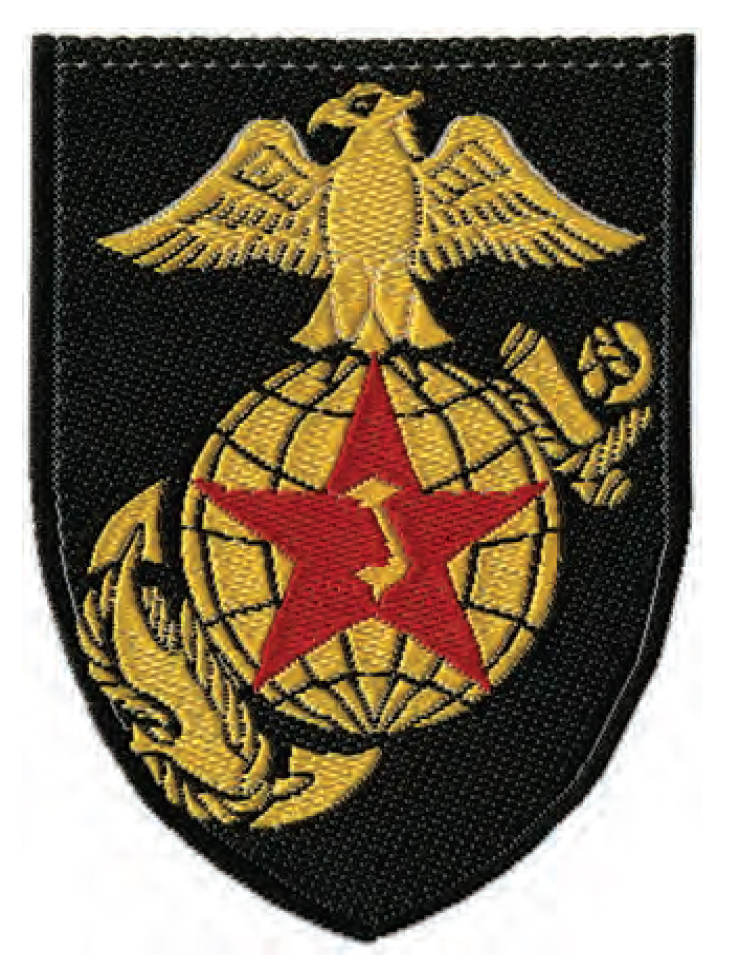
Vietnamese Marine Corps insignia, patterned after the American eagle, globe, and anchor. Courtesy of author
After the acrimonious and confused fighting that began in April and May 1972, this singular defeat would be redeemed later in a singular victory. The combat, so late in the war, was still significant. For the South Vietnamese, it meant they could not hold their own against the North Vietnamese without critical American support. For the Americans, it was a foretaste of the impact of high-tempo conventional operations after the counterinsurgency era. This and the lessons of the 1973 October War (Yom Kippur War) in the Middle East would serve as important preparation for U.S. armed forces in the 1990–91 Gulf War in Southwest Asia.
In 1972, both the Army of the Republic of Vietnam (ARVN) and the U.S. Military Assistance Command, Vietnam (USMACV) asserted that the Vietnamese Marine Corps (VNMC) played a major part in the battlefield defeat that resulted in the loss of Quang Tri City and Province of the Republic of South Vietnam in April and May 1972. This was based on two observations: one, Vietnamese Marine commanders paid more attention to their service leader than their tactical commander; and two, this was caused by pressure from the Vietnamese Marines and their American Marine advisors to fight as a division command for the first time.
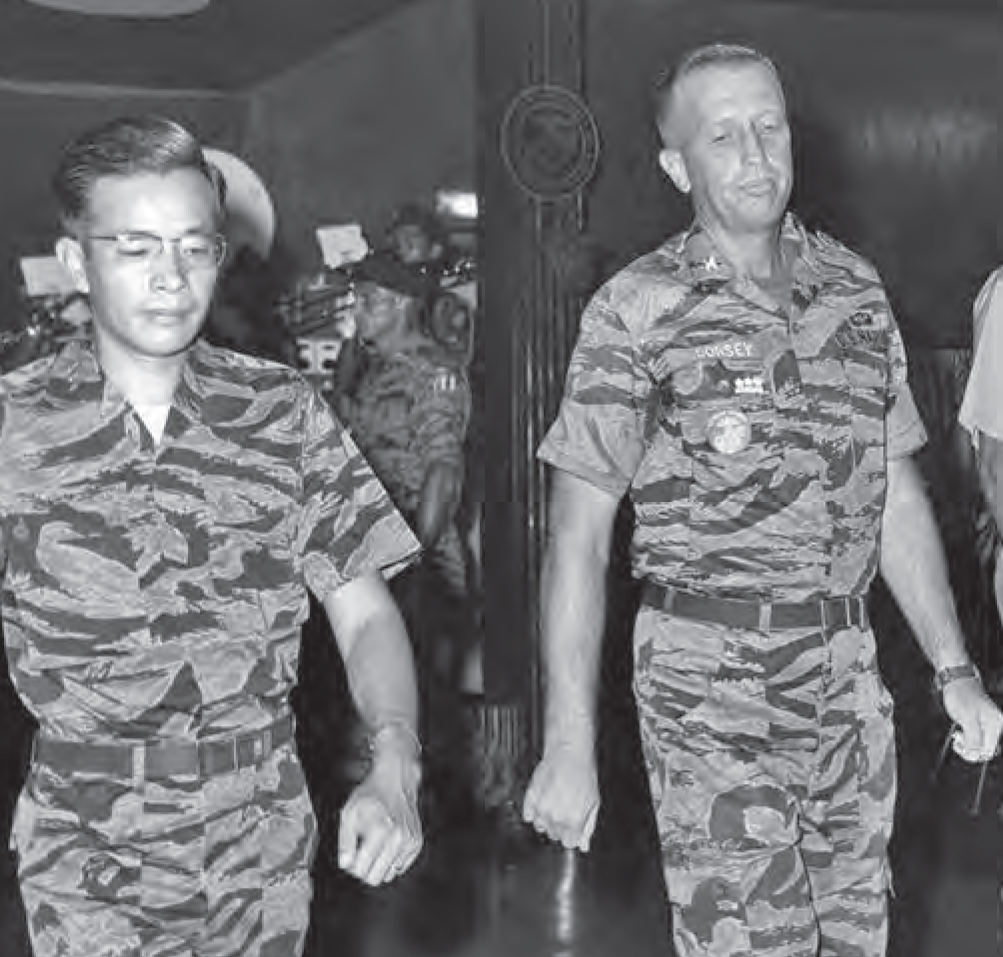
LtGen Le Nguyen Khang, Commandant of the Vietnamese Marine Corps, with Senior Marine Advisor Col Joshua W. Dorsey III. Official U.S. Marine Corps photo
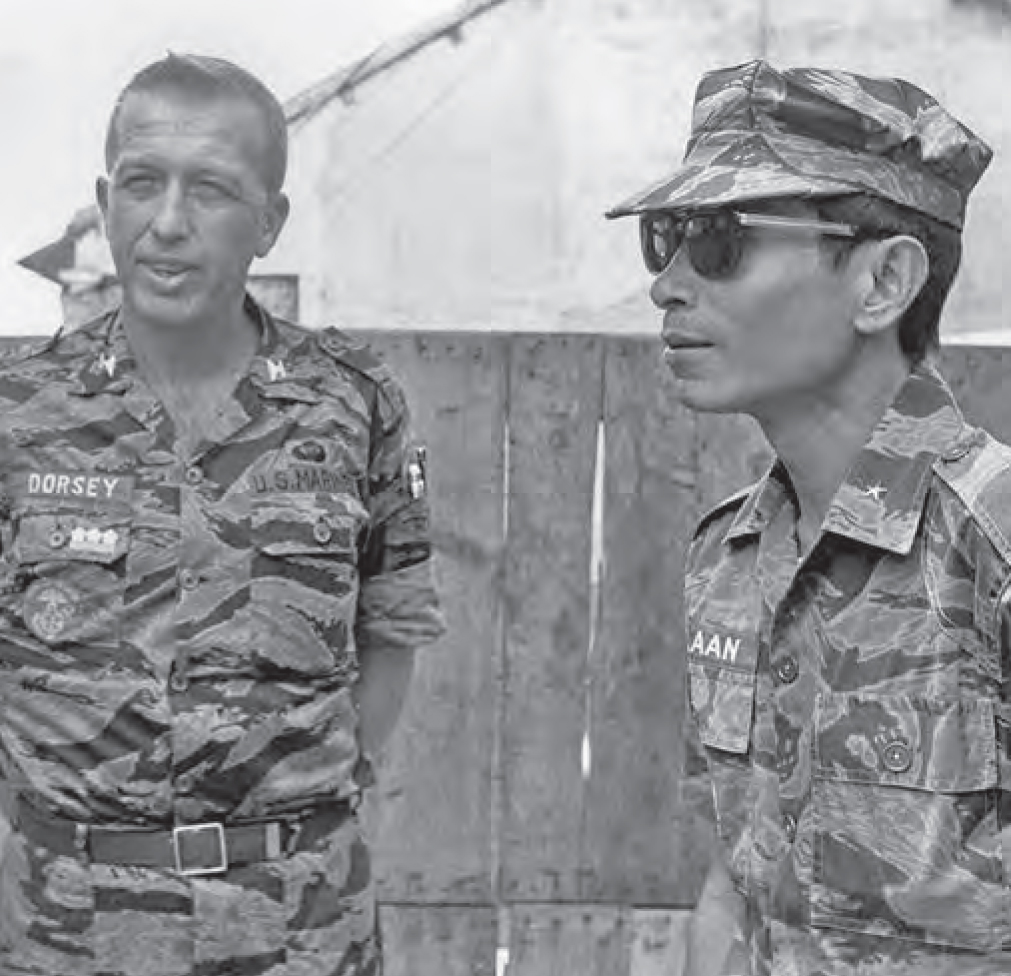
Senior Marine Advisor Col Dorsey with BGen Bui The Lan commanding the Vietnamese Marine Division. Defense Department (Marine Corps) A800666
During the North Vietnamese spring offensive, the South Vietnamese 3d ARVN Division was defeated in a series of engagements that climaxed on 1 May 1972 with the loss of Quang Tri City (first battle of Quang Tri City). The aftermath of this event was muddied by acrimonious disputes among American forces over the conduct of the defense of Quang Tri Province in MR 1 (or ARVN I Corps), which saw the U.S. Army advisors withdraw while U.S. Marine advisors remained with their Vietnamese counterparts. The actions and motivation of the Vietnamese Marines were subjected to various interpretations: senior 3d ARVN Division advisor, U.S. Army Colonel Donald J. Metcalf, stated that the VNMC lost Quang Tri City; First Regional Assistance Command’s Army Major General Frederick J. Kroesen Jr. implied it; and USMACV’s Army General Creighton W. Abrams Jr. directed his ire against both VNMC and ARVN armored units—at least until he departed Vietnam in June 1972, which coincided with the beginning of the successful counteroffensive to regain both the province and city by the VNMC and ARVN airborne divisions supported by American air and naval forces.
As early as 1974, Australian Army Brigadier Francis P. Serong repeated claims of VNMC misconduct, similar to those made by ARVN and U.S. Army personnel.1 U.S. Army General William C. Westmoreland even commented on the misconduct in his memoirs in 1976.2 And the debate created by Colonel Gerald H. Turley—one of the Marine advisors’ most vocal participants—in his 1985 book continued to fuel the unsubstantiated charges of Vietnamese Marine misconduct more than a decade after the debacle.3
In Their Own Image
In 1954, a scattering of riverine commandos was designated as the “Marine infantry” of the Republic of Vietnam Navy, later known as the Vietnamese Marine Corps (VNMC or TQLC in Vietnamese). The Marine infantry became part of the armed forces general reserve and was separated from the Vietnamese Navy in 1965 and from then answered only to the Joint General Staff of the Republic of Vietnam Armed Forces (RVNAF). It expanded from a solitary battalion to nine infantry battalions and three artillery battalions in a multibrigade structure along with service and support units. Also present was a small advisory team of U.S. Marines as part of the Cold War proliferation of the Marines Corps in the area of the U.S. Pacific Command, which included Korea, Vietnam, Nationalist China, the Philippines, and Indonesia. American forces brought a background based on established naval amphibious forces, division-level employment, and a legislated structure. As a result, the vision of a Vietnamese Marine Division reflected the organization and doctrine that the United States was familiar with. This concept was fostered by Vietnamese attendance at Marine Corps schools and the material support of the advisory effort. Despite resistance from the ARVN and USMACV command structures, by 1968, the goal of a full division of Marines was a priority for Lieutenant General Le Nguyen Khang, the VNMC commandant, and his advisors. Divisional structure was reached by 1970, but no large scale employment occurred. The pressure for this structure increased with external operations in Cambodia in 1970 and Laos in 1971. Those operations deserve a closer look (which is not possible in this limited analysis) due to the friction that occurred with the respective VNMC and ARVN command structures. Difficulties also arose between the VNMC brigade commanders and acting division commander, Colonel Bui The Lan.4
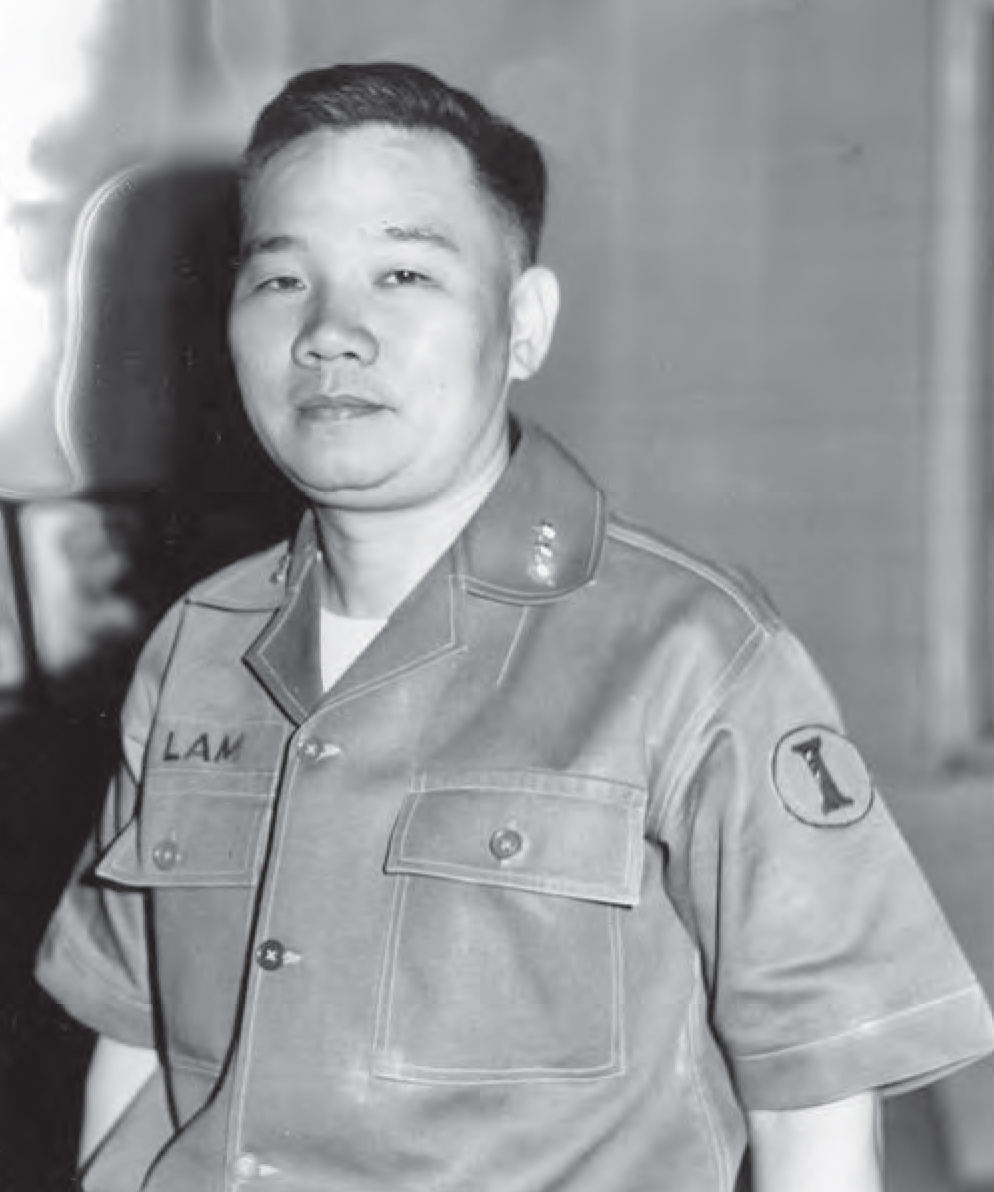
LtGen Hoang Xuan Lam, the senior South Vietnamese leader in MR 1, advised in 1972 by MajGen Frederick J. Kroesen Jr., commanding the 1st Regional Assistance Command in Da Nang. Defense Department (Marine Corps) A193103
Prelude To Defeat
By 1971, with the departure of most American combat units from MR 1, VNMC brigades were deployed in rotation to Quang Tri Province and placed under ARVN command. Even with a deployment to Laos in February 1971, under Lieutenant General Hoang Xuan Lam (who commanded I Corps) as part of Operation Lam Son 719, the Vietnamese Marines did not operate at any greater level.5 General Khang and his American advisors felt General Lam did not support the VNMC units and gave Lam the nickname “Bloody Hands” for his expenditure of Marine lives during the failed incursion. The extent to which politics overrode tactical decisions was difficult to gauge when VNMC requests to withdraw were met by comments of “Now the Marines will have to fight.” Speculation circulated that the damage to the Vietnamese Marines was the desired result to weaken the Khang-Ky (South Vietnamese Vice President Nguyen Cao Ky) faction, just as the losses to the Vietnamese airborne had impacted the Lam-Thieu (South Vietnamese President Nguyen Van Thieu) faction in the Vietnamese government.6 This was an example of the complex network of political, professional, and familial relations that shifted within the politics of USMACV and the Vietnamese.7
A more significant factor with Lam Son 719 was that the Americans provided critical control of maneuver and fire support, which should have come from the Vietnamese forces. The senior American commander in Vietnam, General Abrams, concluded in July 1971 that the Vietnamese suffered from weak leadership and the inability to control American firepower. Abrams did not expect American advisors to “play a major role in the improvement of South Vietnamese military forces.”8 The Vietnamese Marines learned from combat with the North Vietnamese Army (NVA) and adjusted accordingly, and even the ARVN noted the Marines had retained unit integrity regardless of losses.9
In the fall of 1971, the 3d ARVN Division, the Ben Hai Division, was formed and assigned the defense of the demilitarized zone. Vietnamese Marine units in this area of operations came under the command of Brigadier General Vu Van Giai, the division commander for tactical matters, but still remained firmly under VNMC control for material and political support. The relationship of separate military organizations was based upon the degree of support provided: general, direct, or attached. In theory, an attached unit was supposed to be given the same level of consideration and support as one belonging to the parent command; in practice, this was often not the case. According to General Kroesen, the senior American in MR 1, General Giai was not satisfied with Marine responsiveness to his orders, but the brigades were combat tested, fully reliable, and respected. General Kroesen observed that the brigades’ ability to rotate forces proved vital in maintaining combat effectiveness. Significantly, they were well supplied, equipped, and maintained at effective strength by Marine logistics and replacement channels.10
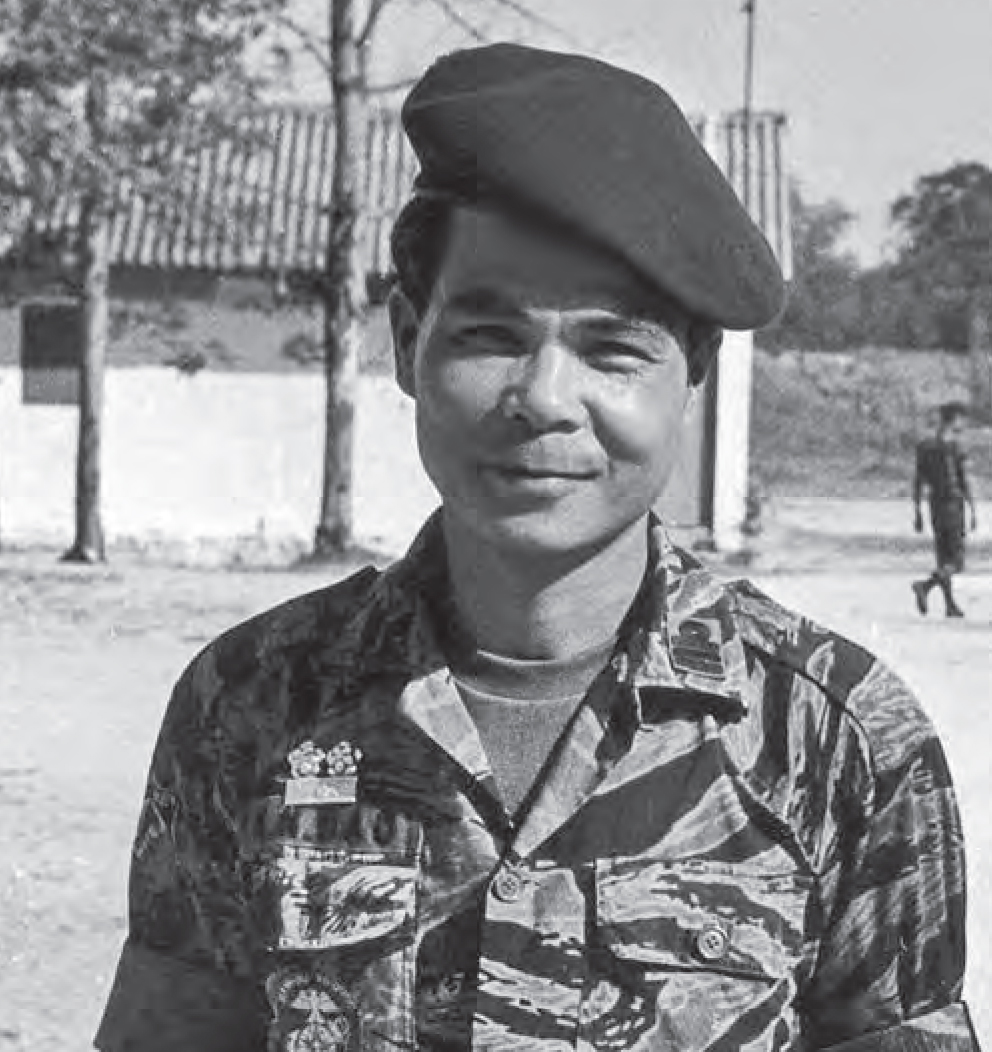
LtCol Nguyen Nang Bao commanding VNMC Brigade 147. Marine Advisory Unit photo
The Spring Offensive
This arrangement was battle tested on 30 March 1972 when the North Vietnamese began conventional attacks coinciding with the continued withdrawal of American forces from the region. By this time, U.S. troop levels were at 69,000, leaving 11 maneuver battalions, 3 artillery battalions, and no fighter aircraft squadrons in-country.11 The Communists invaded with an initial wave of six divisions—an effort that struck toward Quang Tri and Hue cities in MR 1, Kon-tum and Pleiku in MR 2, and An Loc and Saigon in MR 3. The People’s Army of Vietnam, or NVA, relied on bad weather and combined arms to defeat the South Vietnamese, which were believed to lack effective American support.12 The magnitude of the attack was such that ultimately up to 12 NVA divisions entered South Vietnam on these three fronts.13 The USMACV First Regional Assistance Command in MR 1 reported that three divisions, five separate infantry regiments, seven sapper battalions, three or more artillery regiments, and two armored regiments were used in the Quang Tri Province attacks.14 The American response was to counter with air and naval strikes along the demilitarized zone in South Vietnam and then in North Vietnam.
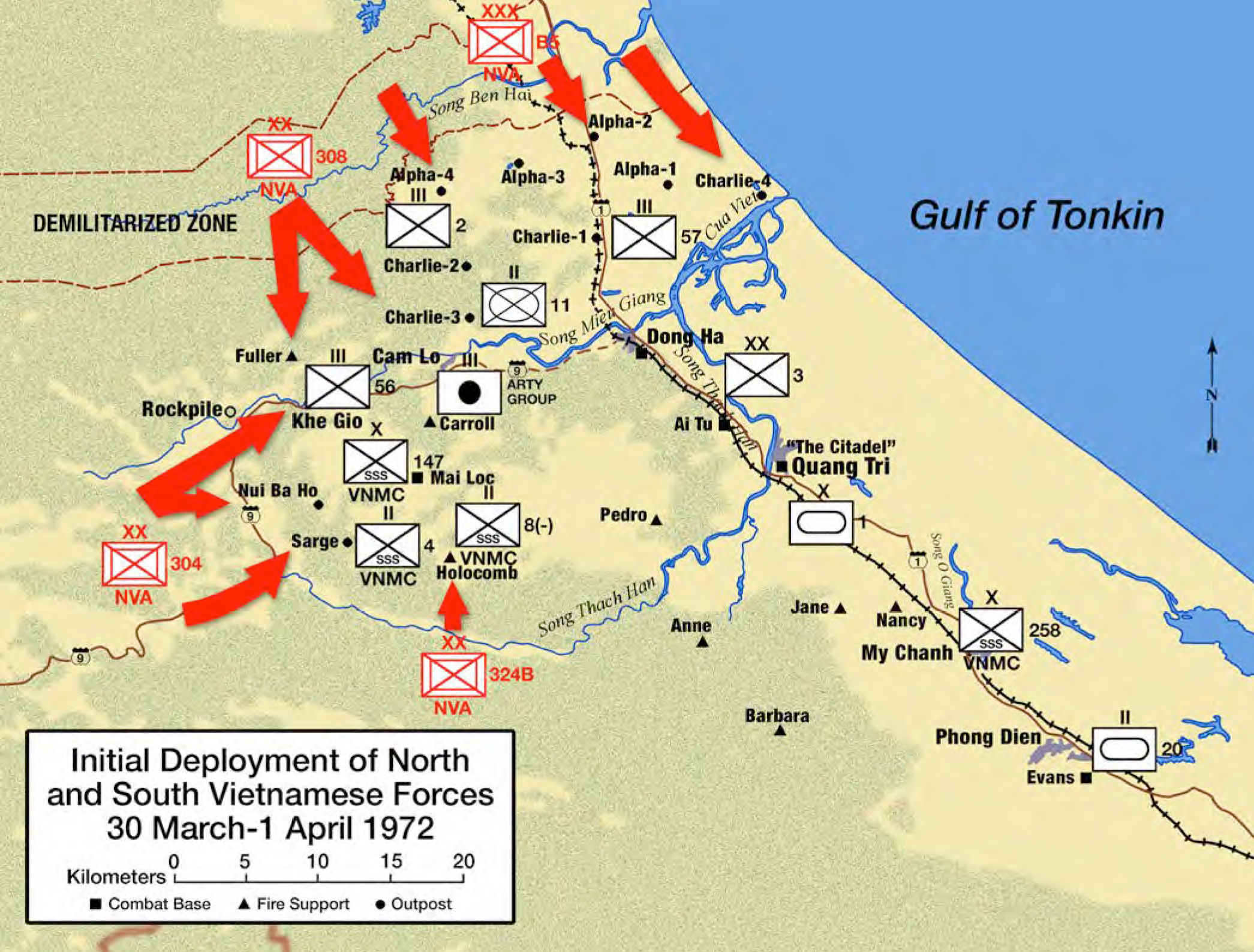
Map by W. Stephen Hill
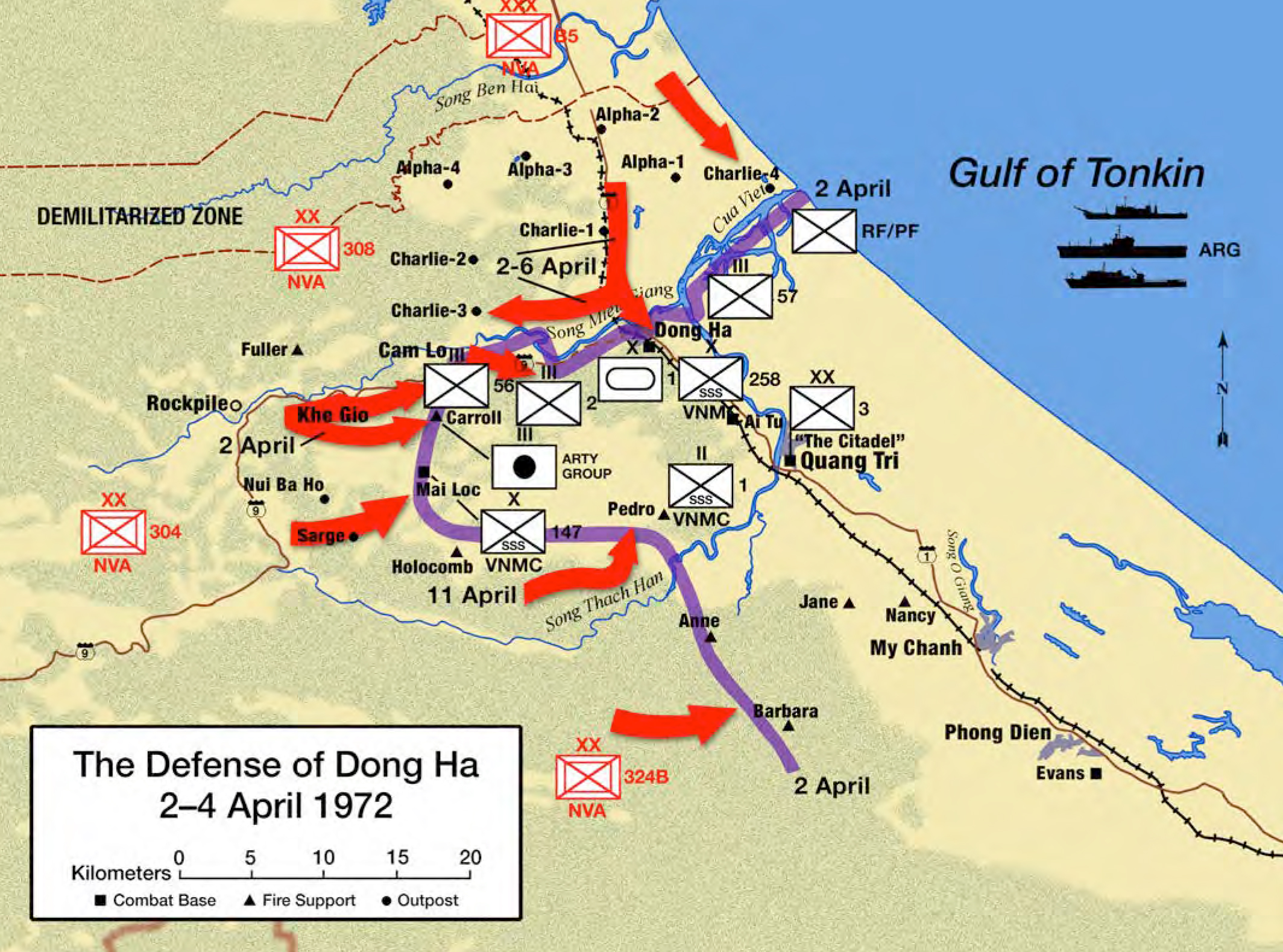
Map by W. Stephen Hill
From 30 March to 4 April 1972, the 3d ARVN Division suffered the destruction or capitulation of its 56th ARVN Regiment and division artillery group while conducting harrowing withdrawals of the 57th ARVN Regiment and Marine Brigade 147. Eight South Vietnamese fire support bases were lost before the Communists paused in MR 1 to refuel and refit, as strong attacks continued in MR 2 and MR 3. Marine Brigade 258 and the 1st ARVN Armored Brigade barely held at Dong Ha as General Giai regrouped his division south of the Cua Viet River during the first week of April. With a forward command post at the Ai Tu Combat Base, General Giai’s main headquarters stayed at the Quang Tri City Citadel, along with USMACV Advisory Team 155.15 However, the Vietnamese Marine Division G-3 operations advisor, Lieutenant Colonel Gerald H. Turley, concluded that “the main North Vietnamese thrust was halted and the Communist army’s time schedule for seizing Quang Tri City within seven days was disrupted.”16 On 3 April 1972, the Vietnamese Joint General Staff sent the entire Vietnamese Marine division to MR 1, but General Khang was directed to place his brigades under the operational control of General Lam, commander of I Corps.17 While the 3d Division held Dong Ha from attacks across the demilitarized zone to the north, the emphasis of the battle shifted significantly to the western approaches of the Ai Tu Combat Base and Quang Tri City. From 9 to 11 April, the battle swung in the balance around Fire Support Base (FSB) Pedro with substantial artillery and armored duels.18 Lieutenant Colonel Turley reported that “the invading North Vietnamese divisions continued to press their attacks toward Quang Tri City with enemy armor and infantry forces using the Cam Lo Bridge as their primary crossing point. Once south of the Cam Lo-Cua Viet River, NVA units moved on Dong Ha from the west. Other enemy forces moved south, passing FSB Carroll and Mai Loc, toward Route 557 and FSB Pedro.”19 There, the first enemy tank-infantry assaults were repulsed by defending Vietnamese Marines and left NVA dead and destroyed vehicles on the battlefield. Attempts by General Lam to conduct a counteroffensive from 14 to 23 April (Operation Quang Trung 729) failed to get off the ground despite heavy American air support, including strategic B-52 bomber Arc Light strikes. This slow rate of advance only seemed to focus NVA attention on the westward approaches to Quang Tri and Hue City.
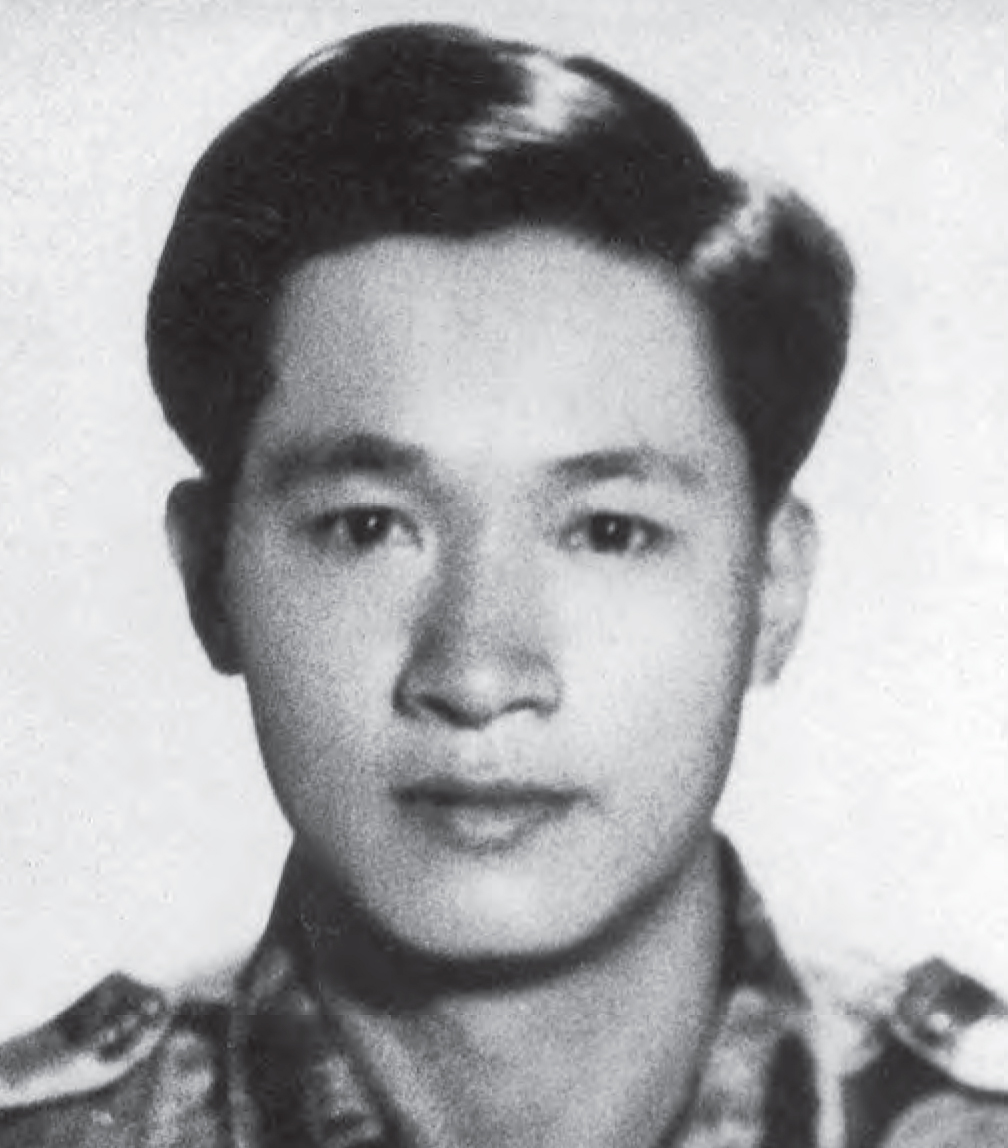
LtCol Ngo Van Dinh commanding VNMC Brigade 258. Marine Advisory Unit photo
The demands on the 3d Division command and control system, which was reinforced with as many as 36 battalion-size units, increased. Kroesen pointed out that at no time were the 3d ARVN Division’s logistics resources expanded and that communication links continued to be maintained with outside commands to ensure needed support. South Vietnamese materiel losses were estimated by MACV as 18 155mm and 45 105mm guns or howitzers, 37 tanks, and 89 armored personnel carriers—a total of more than 240 vehicles of all kinds. Personnel losses through death, injury, or desertion could only be estimated. Colonel Donald J. Metcalf, the senior U.S. Army advisor to General Giai, believed this arrangement did not carry “the allegiance and loyalty” necessary to conduct successful combat operations.20 Despite these difficulties, Lam refused to use the two division-level headquarters placed at his command by the Joint General Staff, the Vietnamese Marine Division, and the ARVN Ranger Command. The chairman of the general staff, General Cao Van Vien, recalled they were “never utilized or given a mission.”21 General Kroesen wrote that Lam dismissed suggestions to provide a multidivision structure to fight the battle north of the Hai Van Pass as “unnecessary and impractical.”22
Lam’s focus on the premature counteroffensive prevented him and his staff from even considering the obvious problems of defending Quang Tri or Hue. The Vietnamese command issues of Lam Son 719 were felt again when Lam and Khang refused to deal directly with each other. As a result, General Kroesen and Colonel Joshua W. Dorsey III, the senior Marine advisor to General Khang, served as the only means of contact between the two Vietnamese generals. According to the Marine Division G-3 advisor, Khang and his staff monitored every move of Marine Brigades 147, 258, and 369 as they waited impatiently to assume control of all three brigades.23
For Kroesen, the lack of effective authority within I Corps became obvious with the ARVN Marine Division and Ranger Command in issuing guidance, responding to complaints and questions, and providing “unsought advice and counsel concerning their forces to anyone who would listen.”24 General Lam compounded this by going directly to 3d ARVN Division units—particularly the 1st ARVN Armored Brigade, whose advisor, U.S. Army Lieutenant Colonel Louis C. Wagner Jr., complained about receiving orders from the corps commander, the corps commander’s deputy, and his operations officer.25 General Kroesen concluded that all this undercut the authority of General Giai by planting the seeds of distrust and disobedience that would culminate at the end of the April in near mutiny.26
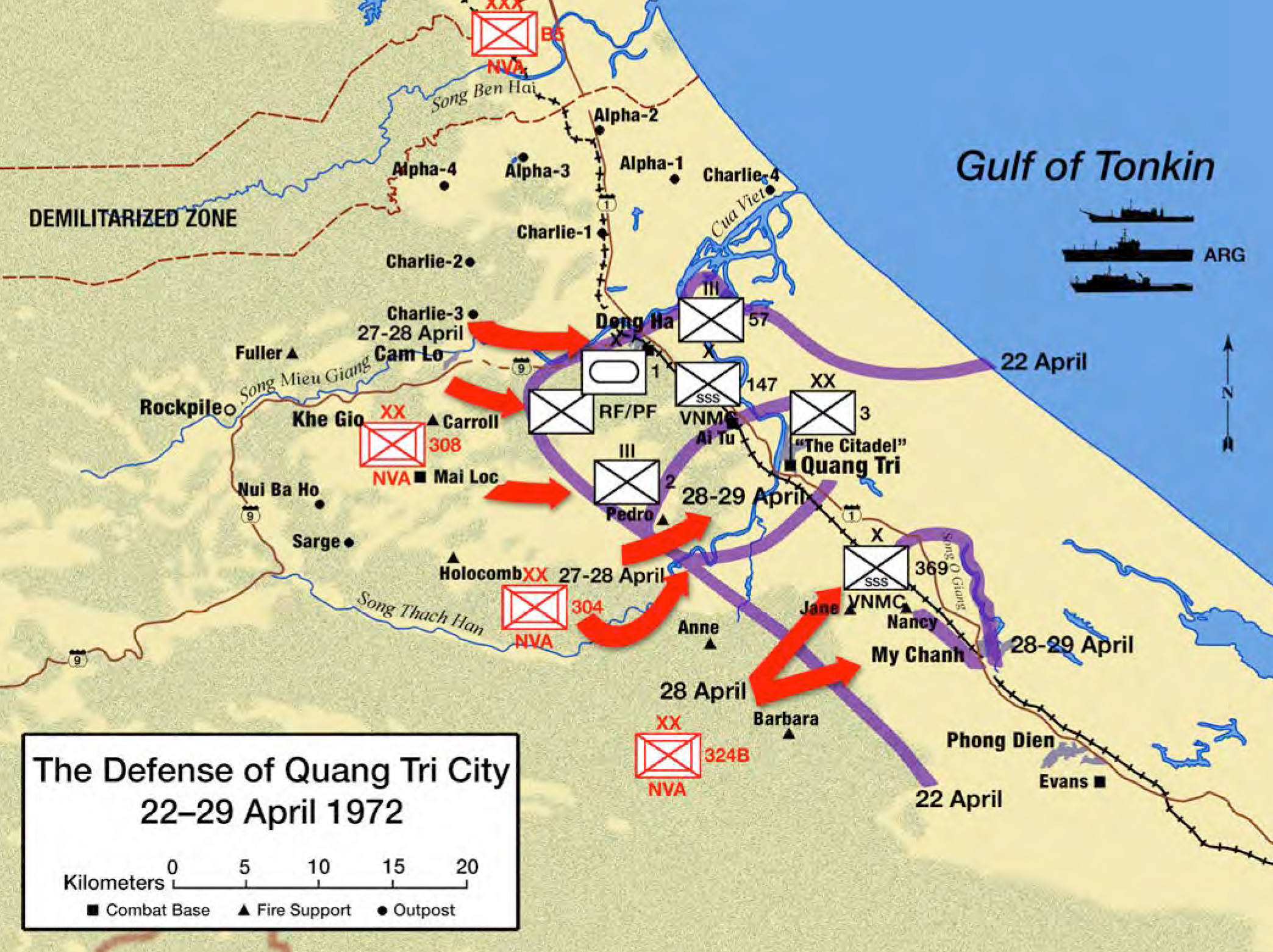
Map by W. Stephen Hill
At this stage, by 24 April 1972, the 3d ARVN Division was organized around five mixed task forces. The 1st ARVN Armored Brigade along with the 57th ARVN Regiment held the area from Highway 1 to five kilometers east, bounded by the Cam Lo River in the north and the Ai Tu Combat Base in the south. Marine Brigade 147 was at the Ai Tu Combat Base with the division forward command post, conducting defensive operations in an arc to the west. The 2d ARVN Regiment defended the area southwest of Ai Tu to the Thach Han River. The 1st ARVN Ranger Group was located south of the Thach Han River, and Marine Brigade 369 was farther south near Hai Lang on FSBs Nancy and Jane while Marine Brigade 258 was refitting at Hue.27 General Kroesen described a pattern of action then established within the 3d ARVN Division’s area where “no orders, threats, or exhortations” were able to force subordinates to move or stay if they disagreed. Both Generals Lam and Giai were losing control on the battlefield to this general state of confused inertia because each appeared willing to let American airpower win the fight for them.28 Consequently, the North Vietnamese Army moved to cut off Dong Ha and Quang Tri City in order to collapse the ARVN defenders.
Confusion at Quang Tri City
On 27 April 1972, the North Vietnamese renewed the general offensive throughout the Quang Tri Front. The 308th NVA Division attacked Dong Ha and “liberated” it on the afternoon of 28 April. Communist forces pushed the defenders back toward Highway 1 and south toward Quang Tri City using 122mm and 130mm artillery, T54/55 tanks, and infantry. The 304th NVA Division attacked toward the Ai Tu Combat Base and, at the same time, the 324th NVA Division struck farther to the south. As a result, Highway 1 was blocked and Quang Tri City was cut off from the rest of I Corps.29 This situation was compounded as NVA artillery hit the ammunition dump at Ai Tu Command Base, and stocks went up in blazes. On 29 April, Giai issued orders for a general withdrawal to positions along the O’Khe and My Chanh Rivers but was overruled by Lam.30 The various accounts of events made Giai and Lam’s command dynamics difficult to analyze and explain. General Vien commented that the Quang Tri debacle involved some intricacies “that only the principals could clarify.”31
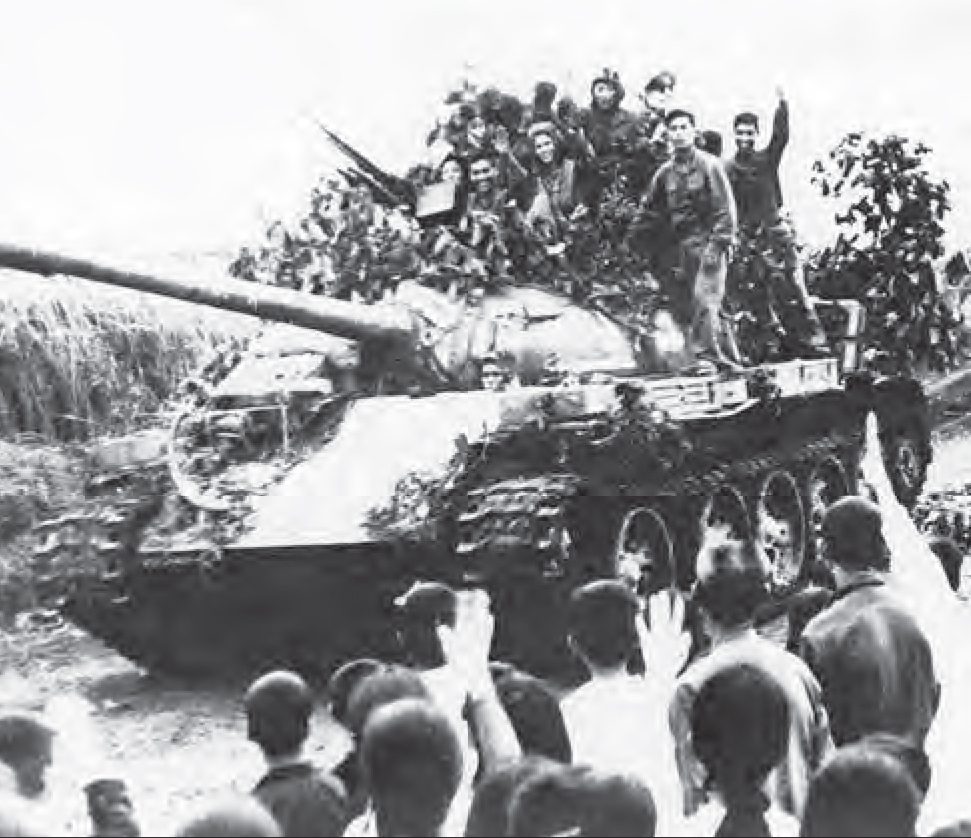
North Vietnamese soldiers on a T54/55 tank are welcomed by civilians as they move south during the Spring Offensive. Viet Nam magazine wartime photo, courtesy of Capt Edwin W. Besch
Early Sunday morning, on 30 April, a regiment size NVA force supported by armor was assembled southwest of Ai Tu. Up to this point, Lieutenant Colonel Nguyen Nang Bao’s Marine Brigade 147 (with brigade advisor Major James R. Joy) had been able to use artillery and tank support to halt the North Vietnamese’s attacks. But then, ammunition supplies were low, and the 20th ARVN Tank Squadron (a battalion-size unit) was being parceled out south of the Thach Han River in an effort to keep Highway 1 open. American naval gunfire could not be used effectively against the enemy staging area, because it was at maximum range. The Marines called in aircraft with attack sorties striking close to the front lines, but even heavy air attacks could not save the untenable salient that had developed north of the Thach Han River.32 Upon seeing the armor moving to the south, the remaining ARVN infantry drifted away from their positions; all types of vehicles began running out of fuel, and rumors were rampant. Colonel Metcalf recalled that several thousand troops and hundreds of vehicles were bunched up on Highway 1 with no escape route except into withering fire and panic. At this stage, according to Metcalf, the higher headquarters—for I Corps, South Vietnamese Marines, and Rangers—all added to the confusion by passing contrary orders, which Giai and his staff were unable to sort out.33
A critical move occurred with the decision to pull Marine Brigade 369 off of FSB Jane and to reopen Highway 1, which exposed the 3d ARVN Division’s whole southern flank. At daybreak on 30 April, South Vietnamese Colonel Pham Van Chung of Marine Brigade 369 (with brigade senior advisor Major Robert F. Sheridan) sent a battalion north to Highway 1 in an attempt to break through to Quang Tri City on orders from the division and I Corps. The battalion met heavy automatic weapon and recoilless rifle fire along the way and waited for these enemy positions to be hit by Allied air strikes. The Marine battalion then reached a bottleneck between the O’Khe River bridge and Hai Lang, where the Communists were positioned along the highway. With the destruction of this enemy force, the exodus of refugees fleeing south came down the road, and the prospect of the battalion linking up with the units in Quang Tri City faded. The Marine battalion was low on ammunition, overextended, and unable to move up the road through the flow of refugees. Colonel Chung directed the battalion to return to the O’Khe River bridge and hold it for the units breaking out from the north.34
The best chance of holding Quang Tri City fell to Marine Brigade 147, the only tactical unit remaining in any condition to fight; Metcalf called the unit “our last ditch defense.”35 At noon on 30 April, General Giai ordered Brigade 147 from the Ai Tu Combat Base into the city proper. The remaining 3d ARVN Division units could then form a defensive line south of the Thach Han River, while the 1st ARVN Armored Brigade tanks and armored personnel carriers were to be used to keep Highway 1 open toward Hue. General Lam was notified of this plan and acknowledged it, but no specific approval was provided and no orders were issued by I Corps.36
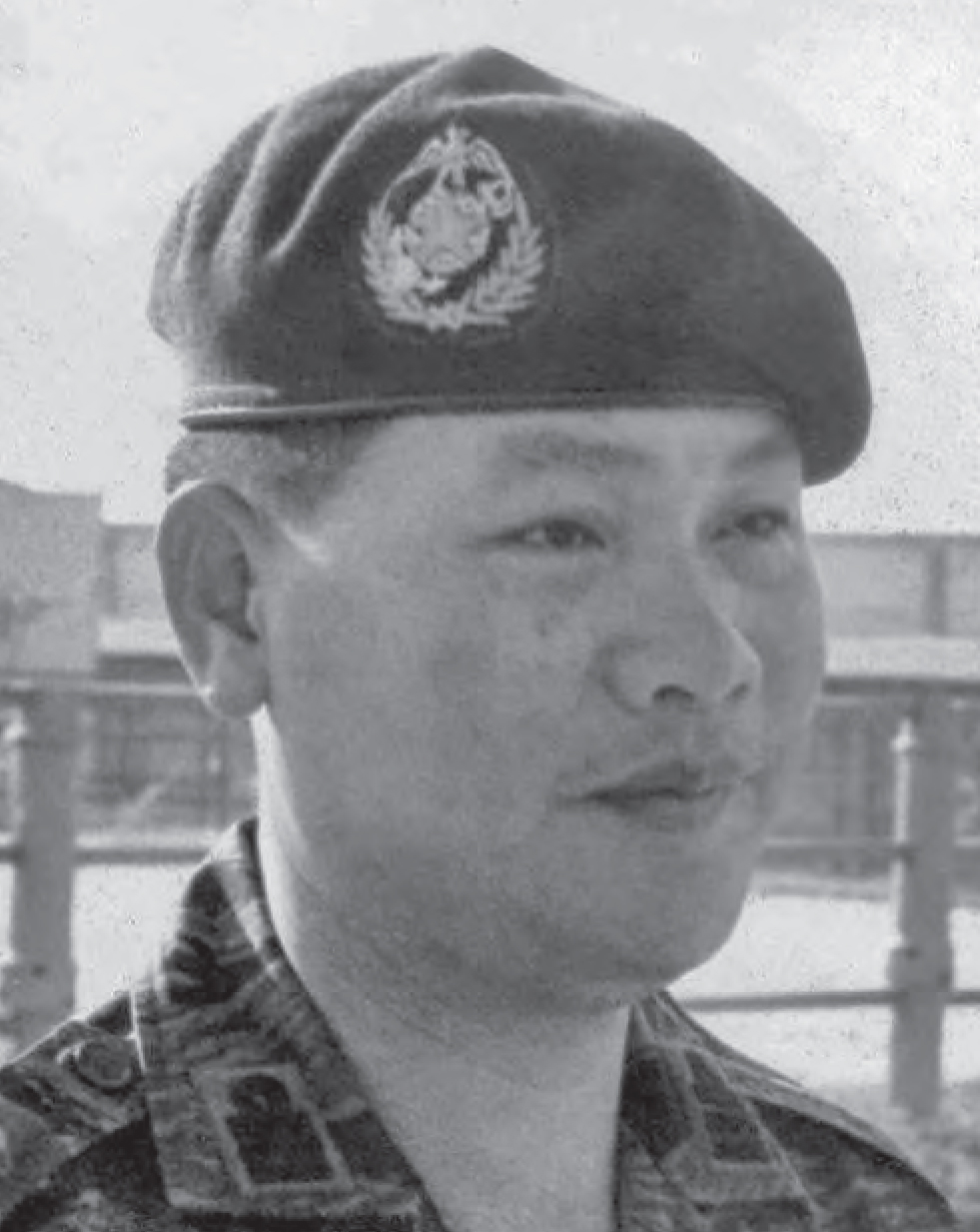
Col Phan Van Chung commanding VNMC Brigade 369. Marine Advisory Unit photo
Lieutenant Colonel Bao and Major Joy were briefed by the 3d Division staff, and the plan began smoothly enough as the brigade headquarters and artillery battalion departed Ai Tu. The Marine advisors effectively directed and controlled tactical air strikes and artillery and naval gunfire missions, slowing the pursuit of the NVA forces and permitting the brigade’s orderly and covered withdrawal. The withdrawal went well until the column reached the approach to Quang Tri City and discovered that division engineers had already destroyed the bridges across the Thach Han River. The Marine infantry waded or swam across the river at the bridge site and moved directly into their fighting positions. The brigade artillery tried to tow its howitzers across a ford, but the swift current and soft bottom of the river slowed the effort; 18 howitzers and 22 vehicles were lost in the attempt. The 1st ARVN Armored Brigade fared worse than Brigade 147 when its recently assigned commander had to destroy 12 tanks, 18 howitzers, and numerous armored personnel carriers for lack of fuel and ammunition. Fortunately, the 20th ARVN Tank Squadron forded the river north of the bridges with 16 of its remaining M48 Patton battle tanks. By nightfall, Brigade 147 and remnant forces occupied the defenses that were planned to hold Quang Tri City.37
Collapse
On the morning of 1 May 1972, General Lam informed General Giai that all Quang Tri positions were to be held, and no withdrawal of any kind was authorized. This directive came from Saigon with Lam receiving his orders from President Thieu.38 Intelligence reports indicated the city would be hit again that evening by a heavy artillery attack estimated at 10,000 rounds of munitions. With this assessment in hand, General Giai decided that any further defense of Quang Tri City would be fruitless. “To protect the lives of all of you,” Giai authorized units to fall back farther south because, at this point, he was in no position to stop them. Giai and Metcalf were in conflict with Metcalf insisting that the Vietnamese Marines could hold the Citadel “indefinitely” with American supporting arms. This had been his advice the previous month when Marine Brigade 258 was left to cover the division’s withdrawal through Dong Ha.39 At 1215 on 1 May, the chief of staff of the 3d Division walked into Advisory Team 155’s bunker and, using the American radio circuits, called all subordinate commanders: “General Giai has released all commanders to fight their way to the My Chanh River!” Within 30 minutes, the I Corps commander, General Lam, again sent his “stand and die” orders. At this point, all of General Giai’s subordinate senior commanders refused to obey, stating Giai could withdraw with them or be left behind; a threat that, according to General Kroesen, they proceeded to carry out. Other units did not respond to the change or refused to deviate from their original orders to pull back.40 Metcalf was left to watch his counterparts on the division staff pack their belongings, totally unaware or concerned by the situation. Shortly afterward, Colonel Metcalf radioed Marine Brigade 147 and said, “The ARVN are pulling out; advisors may stay with their units or join me” for evacuation by helicopter. Major Joy responded that the Brigade 147 Marines would stay with their units.41
Recalling the division’s previous abandonment of the brigade at Mai Loc, Lieutenant Colonel Bao declined to defend what all others were now abandoning. The sight of the 3d Division soldiers departing with their families did nothing to engender the desire for a last stand. Luckily for the Marines, their dependents were in MR 3, unlike most ARVN units whose soldiers fought and lived in the same area. A little after 1430, the brigade headquarters was southwest of the Citadel where the unit expected to be joined by General Giai and his staff before pushing south to link up with Marine Brigade 369 at My Chanh. The move had been coordinated earlier by Joy and Metcalf. In the confusion, the division commander and staff did not arrive. Metcalf stated Giai left him and the other advisors at the Citadel while Kroesen stated the Marines had left Giai with Bao holding the bag for both.42 Metcalf then radioed Joy to inform him that the linkup would not be made and that the American advisors should resort to their own devices; Joy declined. In what was taken as proforma, Metcalf reiterated that the Marine advisors could join him for the helicopter evacuation from Quang Tri City. Major Joy again declined, and the departing Team 155 senior advisor responded, “Good luck!” At 1635, Brigade 147 moved east toward the coast and then turned south. After making several difficult stream crossings, the column arrived in the vicinity of Hai Lang, 10 kilometers south of Quang Tri City.43 The intermingled civilian and military stragglers prevented maneuver on the highway, and the cross-country route used by Brigade 147 was extremely difficult for attached M48 tanks and vehicles, most of which were lost trying to ford the Nhung River.
The South Vietnamese and Americans thought that at least a reinforced North Vietnamese regiment held Highway 1 at Hai Lang and had engaged the fleeing South Vietnamese, halting all movement to the south.44 The interdiction of the road by artillery and infantry weapons earned it the title “Highway of Horror” for the estimated 2,000 civilian and military dead left along the three-quarter-mile stretch of road. One North Vietnamese soldier reported, “The people were moving on bicycles, motorbikes, and buses . . . No one was able to escape.”45
After a long and heated discussion with his battalion commanders, Lieutenant Colonel Bao established a tight perimeter for the night and planned to resume the march the next day. During the morning reorganization, the brigade commanders ascertained that all of their units were still organized and combat effective. Brigade 369’s senior advisor, Major Sheridan, had closely followed Major Joy’s radio traffic in the days preceding the mass exodus.46 Brigade 369’s efforts were directed at keeping the bridges across the O’Khe and My Chanh rivers open for withdrawing troops and civilians. But farther to the south, Brigade 369 had been unsuccessful in keeping the road open between Quang Tri and Hue, although it had inflicted heavy losses on the Communists and had not become pinned down.47
As the last position in Quang Tri Province, FSB Nancy fell the next day on 2 May 1972. General Khang and the Marine division headquarters were ordered by the Joint General Staff to assume command of all Marine units and to defend along the My Chanh River. Two Marine brigades, 147 and 369, were engaged with the enemy, and the situation was confused as to who and what, if anything, were left to aid in the defense. Brigade 258 was still held in reserve, as Khang, his staff, and their advisors went into action defending Hue City.48
In light of this crisis, the Vietnamese National Security Council met with President Thieu and took drastic action to restore order. Outside of Hue along Highway 1, military police units with highly visible sandbagged posts for firing squads acted as a draconian reminder of duty for stragglers from Quang Tri City. The next day, General Lam and his deputy were relieved, and on 4 May, President Thieu went to Hue to place Lieutenant General Ngo Quang Truong in command of I Corps. General Khang was moved to the Joint General Staff as J-3 operations officer after turning down command of II Corps. The Vietnamese Marine Division remained under his deputy, Brigadier General Bui The Lan, to hold the province, lost in part to American and Vietnam- ese interservice rivalry.49 For the first time since the invasion began, the Vietnamese Marines had their own area of operations. Even as they began digging in, the North Vietnamese continued building up their forces to attack toward Hue. By 6 May, the 3d ARVN Division could only account for 2,700 of its men, and General Giai was arrested and later brought to trial for disobeying orders and abandoning his position in the face of the enemy. He claimed that, with food, fuel, and ammunition gone, he saw “no further reason why we should stay on in this ruined situation.”50
Finale
U.S. operations, including Linebacker (aerial bombing), Freedom Train (continued air strikes), and Pocket Money (mining of ports in North Vietnam), did not have an immediate effect on the Communist offensive; the tipping point militarily for this effort came in May 1972.51 In an interesting final note, General Kroesen felt the North Vietnamese’s inability to pursue and destroy routed South Vietnamese forces was evidence that if defended, Quang Tri City might not have fallen. The Communists did not have the resources or organization to do what ARVN forces had done to themselves with American counsel.52 The North Vietnamese doggedly held the Quang Tri Citadel for five months. Claims arose that Marine Brigade 147’s withdrawal on 1 May precipitated the collapse of Quang Tri, even though the unit was the last to leave and stayed long enough for the division commander and his advisors to escape. The brigade actually maintained itself as an effective force by saving lives and equipment, the same logic given by General Giai in his trial.
Real questions should have been directed at the performance of South Vietnamese Army units, particularly the 2d and 57th ARVN Regiments, and General Lam’s conduct. The presence of the Vietnamese Marine division staff and General Khang provided only a backdrop to these events, and even the U.S. Army belatedly recognized the Marines’ drive for division status was correct and valuable.53 Later, the American embassy in Saigon concluded that “Marine units recaptured Quang Tri City on September 16, 1972, after its abandonment by ARVN troops in May 1972.”54 In recognition of this, U.S. Ambassador Ellsworth F. Bunker and the Commanding General of USMACV, Army General Frederick C. Weyand, proposed that the Vietnamese Marine Division receive an American Presidential Unit Citation, which was not approved.55
• 1775 •
Endnotes
*The foundations for this article began at the USMC Command and Staff College Easter Offensive Symposium in December 1986. It was a paper funded by the Marine Corps Heritage Foundation for the Society for Military History Meeting at the Royal Military College of Canada in May 1993, along with presentations by Dale Andrade and How-ard Feng. The account was based on the primary information generated by the events and participants. Documentation came from the Marine Corps Historical Center (MCHC, Washington, DC), the U.S. Army Center of Military History (USACMH, Washington, DC), and the National Archives and Records Administration (NARA, College Park, MD). More recent secondary material was consulted to include John Grider Miller’s The Co-Vans: U.S. Marine Advisors in Vietnam (Annapolis: Naval Institute Press, 2000); Dale Andrade’s America’s Last Vietnam Battle: Halting Hanoi’s 1972 Easter Offensive (Lawrence: University Press of Kansas, 2001); Willard J. Webb and Walter S. Poole’s The Joint Chiefs of Staff and the War in Vietnam, 1971–1973 (Washington, DC: Office of Joint History, 2007); Stephen P. Randolph’s Powerful and Brutal Weapons: Nixon, Kissinger, and the Easter Offensive (Cambridge, MA: Harvard University Press, 2007); Ha Mai Viet’s Steel and Blood: South Vietnamese Armor and the War for Southeast Asia (Annapolis, MD: Naval Institute Press, 2008); and Robert E. Stoffey’s Fighting to Leave: The Final Years of America’s War in Vietnam, 1972–1973 (Minneapolis, MN: Zenith Press, 2008).
- Brig F. P. Serong, “The 1972 Easter Offensive,” Southeast Asian Perspectives, no. 1 (Summer 1974): 32–34.
- Gen William C. Westmoreland, A Soldier Reports (Garden City, NY: Doubleday & Company, 1976).
- Col Gerald H. Turley, The Easter Offensive: The Last American Advisors, Vietnam, 1972 (Novato, CA: Presidio Press, 1985).
- Background on the Vietnamese Marine division includes American Embassy Saigon, Command Histories and Historical Sketches of RVNAF Divisions, 6 February 1973 (MCHC); Capt William D. Wischmeyer, Vietnamese Marine Corps/Marine Advisory Unit Historical Summary, 1954–1973, 22 March 1973 (MCHC); MajGen L. Nguyen Khang oral history intvw, 30 September 1975 (MCHC); MajGen L. Nguyen Khang, “Republic of Vietnam Marine Corps,” Marine Corps Gazette (November 1966): 68; and Col Victor J. Croizat, “Vietnamese Naval Forces: Origin of the Species,” Proceedings (February 1973): 48–58.
- Major operation into Laos by the ARVN between 30 January and 24 March 1971.
- Note that these same arguments emerged again during the defense of Quang Tri in 1972.
- Marine Advisory Unit File, Lam Son 719 Critique Folder (MCHC); Senior Marine Advisor, Combat Operations After Action Report Lam Son 719, 21 March 1971 (MCHC); and Col John G. Miller comments to author, 19 May 1992.
- Jeffrey J. Clarke, Advice and Support: The Final Years, 1965–1973 (Washington, DC: USACMH, 1978), 476, 508; Graham A. Cosmas and LtCol Terrence P. Murray, U.S. Marines in Vietnam: Vietnamization and Redeployment 1970–1971 (Washington, DC: HQMC, 1986), 195–210; and Webb and Poole, The Joint Chiefs of Staff, 1–17.
- For recent accounts of this action, see MajGen Nguyen Duy Hinh, Lam Son 719, Indochina Monographs (Washington, DC: USACMH, 1979), 154; Robert D. Sander, Invasion of Laos, 1971: Lam Son 719 (Norman: University of Oklahoma Press, 2014); and James H. Willbanks, A Raid Too Far: Operations Lam Son 719 and Vietnamization in Laos (College Station: Texas A&M University Press, 2014).
- MajGen Frederick J. Kroesen Jr., “1972 Vietnam Counter-Offensive” (student paper, U.S. Army Command and General Staff College, 1974), 7-4.
- Webb and Poole, The Joint Chiefs of Staff, 395.
- Ibid., 153.
- USMACV, The Nguyen Hue Offensive, 7 January 1973 (NARA). ARVN accounts include LtGen Ngo Quang Truong, The Easter Offensive of 1972, Indochina Monographs (Washington, DC: USACMH, 1979). Communist sources include People’s Army of Vietnam Military Institute, Viet- nam: The Anti-U.S. Resistance War for National Salvation, 1954–1975 (Hanoi, Vietnam: PAVN Publishing House, 1980); Nguyen Khac Vien, ed., Indochina: The 1972–1973 Turning Point, Vietnamese Studies No. 39 (Hanoi: Xunhasaba, 1974); PAVN Senior Military Academy, “Quang Tri-Thua Thien Offensive Campaign,” in Collection of Sketches of Battles, trans. Robert J. Destatte (Hanoi: Ministry of Defense, 1986), 18–19; and ColGen Van Tien Dung, “Some Problems Concerning the Art of Military Campaigns of the Vietnamese People’s War,” People’s Army Magazine, Decem- ber 1973, 61–65.
- First Regional Advisory Command, Intelligence Summary (MCHC), 125–72.
- Webb and Poole, The Joint Chiefs of Staff, 154.
- LtCol Gerald H. Turley and Capt Marshall R. Wells, “Easter Invasion 1972,” Marine Corps Gazette (March 1973): 22. This article offers an excellent summary of VNMC operations in 1972 by the division G-3 advisor.
- Khang intvw; Senior Marine Advisor, Operations Summary Report, VNMC, 11 April 1972–4 May 1972 (MCHC); MACV Advisory Team 155, Daily Staff Journal, 29 April 1972–1 May 1972 (NARA); and Turley and Wells, “Easter Invasion 1972,” 18–29.
- Webb and Poole, The Joint Chiefs of Staff, 157–58.
- Turley and Wells, “Easter Invasion 1972,” 24.
- Col Donald J. Metcalf, “Why Did the Defense of Quang Tri Province, SVN Collapse” (student paper, U.S. Army War College, October 1972), 29.
- Gen Cao Van Vien, Leadership (Washington, DC: USACMH, 1981), 130.
- Kroesen, “1972 Vietnam Counter-Offensive,” 7-7.
- Turley, The Easter Offensive, 231, 245.
- Kroesen, “1972 Vietnam Counter-Offensive,” 7–9; and Vien, Leadership, 132.
- LtCol Louis C. Wagner, 1st ARVN Armor Brigade After Action Report, May 1972 (NARA), 16.
- Kroesen, “1972 Vietnam Counter-Offensive,” 7–9.
- Metcalf, “Defense of Quang Tri Province,” 18–20; and Marine Advisory Unit (MAU) Command Chronology, May 1972 (MCHC), hereafter MAU ComdC.
- Kroesen, “1972 Vietnam Counter-Offensive,” 7–9.
- Webb and Poole, The Joint Chiefs of Staff, 159–60.
- LtCol Louis C. Wagner Jr., 3dARVNDiv Special Message, DTG212529, April 1972, encl. 4 (MCHC).
- Vien, Leadership, 132.
- Senior Marine Advisor, Personal Evaluation of the NVA Easter Offensive, n.d. (MCHC); Maj James R. Joy, Memorandum, 3 May 1972 (MCHC), 16, hereafter Joy memo; Col Charles J. Goode Jr. and LtCol Marshall R. Wells oral history intvw, 19 January 1984 (MCHC); and Maj Glen Golden oral history intvw, 3 July 1975 (MCHC).
- Metcalf, “Defense of Quang Tri Province,” 25–26.
- Col Donald L. Price, comments on author’s manuscript for The War That Would Not End: U.S. Marines in Vietnam, 1971–1973, 10 October 1990 (MCHC).
- Col Donald J. Metcalf, intvw by USMACV, 15 September 1972 (NARA), 8; and Vien, Leadership, 133.
- Metcalf intvw, 8–9; Kroesen, “1972 Vietnam Counter-Offensive,” 7–10; and Maj David A. Brookbank, USAF, Special Report of Air Liaison Officer, 31 July 1972 (MCHC), 20.
- MAU ComdC; Joy memo, 14; and LtGen D’Wayne Gray, comments on the author’s manuscript for The War That Would Not End, 9 December 1989 (MCHC).
- Gen Frederick J. Kroesen Jr., comments on the author’s manuscript for The War That Would Not End, 3 January 1990 (MCHC); and Vien, Leadership, 133.
- Metcalf, “Defense of Quang Tri Province,” 27.
- MajGen Frederick J. Kroesen Jr., message to Gen Creighton W. Abrams, 2 May 1972, Abram’s Papers (USACMH).
- The evacuation was accomplished by USAF Sikorsky HH-3 Jolly Green Giant search and rescue helicopters, although the offshore U.S. Navy and Marine amphibious ready group was alerted as a backup.
- Metcalf intvw, 9; Kroesen, “1972 Vietnam Counter-Offensive,” 19; and Joy memo, 17.
- Ibid., 11–12.
- Maj Anthony P. Shepard, comments on the author’s manuscript for The War that Would Not End, 11 January 1990 (MCHC).
- Government of South Vietnam, The Communist Policy of Terror (Saigon: RVN Ministry of Foreign Affairs, 1972), 41–42; and Government of South Vietnam, La Route De L’Horreur (Saigon: RVN Ministry of Information, 1972).
- LtCol Robert F. Sheridan, comments on the author’s manuscript The War That Would Not End, 20 March 1990 (MCHC).
- Maj William T. Sweeney, memorandum, 8 May 1972, Senior Marine Advisor Evaluation Folder (MCHC).
- Senior Marine Advisor, Historical Summary 1972, 13; Brigade 258 Advisor’s Log, 2 May 1972, Marine Advisory Unit File (MCHC); and Price comments.
- Vien, Leadership, 134.
- Turley, The Easter Offensive, 203.
- Webb and Poole, The Joint Chiefs of Staff, 161–62.
- Kroesen, “1972 Vietnam Counter-Offensive,” 7–11.
- A Study of Strategic Lessons Learned in Vietnam, vol. 6, Conduct of the War: Book 1 Operational Analyses (New York: BDM Corp., 1980).
- Embassy of the United States of America, Saigon, Vietnam, Marine Division, 6 February 1973 (MCHC).
- Embassy of the United States of America, Saigon, Vietnam, Unit Award Recommendation, 1 December 1973 (MCHC), 1–3.